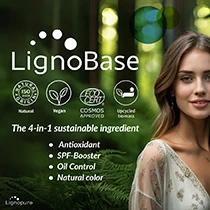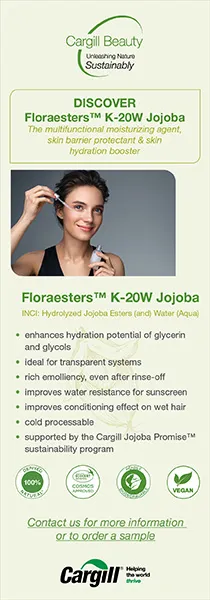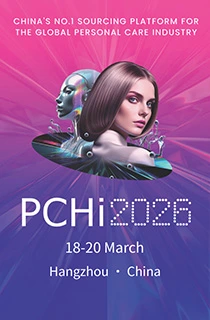Free-from claims captivate color cosmetic realm as natural processing techniques proliferate

19 Sep 2023 --- Consumer demand for natural ingredients and processing methods has made its way into the color cosmetics realm, with recent studies in MDPI and Agronomy showing a significant interest in the creation of naturally processed red from macerated fruit.
Personal Care Insights also shares global market data within this space, while looking at recent multifunctional color cosmetics launches alongside research on the benefits of colorless carotenoids for UV protection.
Product launches featuring cosmetic colorants have seen a compound annual growth rate of more than 6% globally in the last five years, suggests Innova Market Insights data. From April 2022 to March this year, the main new product launches were lipsticks (26%), face foundation (25%), face illuminators (25%) and face concealer formulations (10%).
The CAGR data reveals that there has been a 19% increase in product launches of face concealers in the last five years, 13% in face and body bronzers and a 12% for foundations and illuminators.
Free from claims are peaking with accelerated launches in non-GMO, ammonia and palm oil, while synthetic beeswax is the fastest-growing ingredient for cosmetics.
Macerated fruit steeps a good rouge
Creating a natural, vibrant red requires meticulous processing. In a study published in Agronomy about the dynamic maceration of Acerola to extract anthocyanins, the researchers investigate the best extraction processes to maintain the color and flavonoids.
The tropical fruit Acerola is used to develop the desired hues from anthocyanins and natural pigments, with several applications in the nutraceutical, cosmetic and food segments. The study highlights the renewable potential of acerola fruit waste for obtaining natural anthocyanin extracts, a sustainable alternative to artificial colorants. Extraction is the most critical step to getting natural colorants from plant materials. Chantecaille Wild Meadows Lip Chic lipstick is infused with hyaluronic acid, which helps to hydrate the lips.
Chantecaille Wild Meadows Lip Chic lipstick is infused with hyaluronic acid, which helps to hydrate the lips.
Extraction is the most critical step to obtain natural colorants from plant materials and depends on the intrinsic properties of the plant materials as well as processing temperature, time and the solvents used.
The researchers advocate for dynamic maceration as a simple, easy and inexpensive method to extract anthocyanins where the material is in continuous contact with a solvent while agitated or stirred at a controlled temperature. Extraction at 41°C with 12% ethanol yielded 57.1% (w/w) with each gram of extract containing 2.54 mg of anthocyanins.
Innova Market Insights’ data suggests the top cosmetic colorants from April 2022 to March 2023 are titanium dioxide 93%, iron oxide red 85%, iron oxide black 79% and iron oxide yellow 76%. The lycopene pigment has grown fastest from April 2018 to March 2023, with a CAGR of more than 152%.
The data finds a high growth in cosmetic color formulations at 174%, also targeting men.
Tapping Shikonin for antioxidants
Researchers from the University of Orleans, Nicolaus Copernicus University, the University of Naples Federico II, Slovak University of Agriculture and Botswana International University of Sciences and Technology conducted a study into the natural naphthoquinone compounds of Shikonin produced in the roots of Boraginaceae to establish how it can be used commercially in cosmetics and food applications. The findings were published in Materials, MDPI.
The red pigments were traditionally used to color silk, as food colorants and in Chinese traditional medicine.
The compounds are in high demand again because of consumer interest in natural and plant-based products and their diversity of biological properties, including antioxidant, antitumor, antifungal and anti-inflammatory.
The researchers recommend using these bioactive molecules’ antioxidant properties and skin-whitening effects in various cosmetic formulations. They suggest that techniques in computational biology, bioinformatics, molecular docking and artificial intelligence in laboratory and clinical trials can help turn these compounds into promising alternative natural bioactive therapeutics with multiple uses.
Casting light on colorless carotenoids
While research into the benefits of colorful carotenoids is well-documented, the colorless varieties, such as phytoene and phytofluene, are less so. Recently, it has received considerable attention in nutrition, dermatology and aesthetics.
Researchers from the University of West Attica in Greece conducted a study highlighting why more attention should be given to the colorless carotenoids. The findings were published in MDPI.
Carotenoids are readily bioavailable and can absorb ultraviolet radiation. A diet rich in carotenoid-containing products can positively impact skin health and overall well-being. The lycopene pigment has seen the fastest growth in the last five years.
The lycopene pigment has seen the fastest growth in the last five years.
The study suggests that future studies should focus on generating more data about phytoene and phytofluene levels in the skin to assess skin carotenoid status accurately. This expanding area of research holds promise for the development of novel applications in the fields of health and cosmetics.
Colorless carotenoids have properties such as oxidation sensitivity, stiffness, aggregation tendency and fluorescence in the case of phytofluene.
Humans have used carotenoids topically for cosmetic purposes long before their scientific discovery. Carotenoid-containing natural substances, such as plant extracts or oils rich in carotenoids, have been applied to the skin for their potential benefits, such as skin conditioning, moisturizing and providing a subtle color or glow.
Emerging evidence suggests that phytoene and phytofluene may be involved in the health benefits traditionally attributed to colored carotenoids like lycopene, as they often occur together in foods. These carotenoids have distinct characteristics, including the ability to absorb UV radiation.
According to the researchers, future studies should focus on generating more data about phytoene and phytofluene levels in the skin to assess skin carotenoid status accurately.
Moreover, mechanistic studies are needed to understand the specific benefits of colorless carotenoids in the skin, such as their potential for skin whitening and improving aging signs.
Multifunctional color cosmetics
In finished products, Vantage has launched its Effortless Color formulation collection for multi-functional color cosmetic essentials featuring eight prototypes crafted from high-performing actives, natural oils and silicone alternatives.
The collection’s hybrid foundations, multi-use blushes and bold lip formulations feature actives, natural oils and natural silicone alternatives.
The latest installment in its Spark Inspiration quick formulation program offers cosmetic chemists and formulators a starting point to accelerate their innovation pipeline as they create new product formulations.
The eight Effortless Color formulations range from hybrid foundations to multi-use blushes and bold lip products. The new collection is aimed at accelerating its beauty customers’ innovation pipeline.
“Guided by market insights revealing that more than two-thirds of US makeup users seek multi-functional products, we’ve meticulously curated formulations that honor the diverse spectrum of beauty through effortless yet multifaceted essentials,” says Sebastien Massard, global director of strategic marketing, personal care, Vantage.
By Inga de Jong












